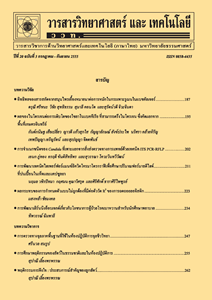Carbon Footprint of Faculty of Public Health, Mahidol University, Phayathai Campus
Main Article Content
Abstract
Corporate organizations are significant sources of greenhouse gas emission, which is the cause of global warming. Estimation of carbon footprint for organization (CFO) is the practical first step toward creating quantifiable emission reduction of organization operations. Thus, this study was carried out to measure the amount of CFO by calculating greenhouse gas emission in a unit of carbon dioxide equivalent (CO2eq) from the activities of the Faculty of Public Health, Mahidol University. The quantity of energy and resources used in 2018 were multiplied with emission factors to obtain CFO. The result showed that a total greenhouse emission from the Faculty of Public Health was 1,594 ton CO2eq/year or 3.036 ton CO2eq/cap. Among the resources used, electricity consumption, solid waste disposal, and water supply consumption were associated with the highest contribution accounting for 1,470.97, 30.87, and 26.13 ton CO2eq/year, respectively. These resources are responsible for 92.3, 1.9, and 1.6 % of total emission, respectively. However, comparing of each building, the 1st, 7th, and 6th building were the major sources of GHGs emission, contributing to 28.6, 20.5, and 16.5 % of total emission, respectively. Since the highest percentage of CFO derived from electricity use, saving energy measures and energy-saving technologies should be seriously taken to help reduce greenhouse gas emission in the Faculty of Public Health, Mahidol University.
Article Details
References
Thailand Greenhouse Gas Management Organizaton, Guildline of Carbon Footprint of Organization, Available Source: http://thaicarbonlabel.tgo.or.th/admin/uploadfiles/download/ts_2608b93bf5.pdf, January 31, 2020. (in Thai)
European Commission DG Environment, 2010, Product Carbon Footprinting – a study on methodologies and initiatives, Ernst & Young and Quantis for European Commission (DG ENV), 307 p.
Department of Environmental Quality Promotion, United Nations Framework Convention on Climate Change: COP 21 and role of Thailand, Ministry of Natural Resource and Environment, Bangkok. (in Thai)
Aroonsrimorakot, S., Yuwaree, C., Arunlertaree, C., Hutajaroen, R. and Buadit, T., 2013, Carbon footprint of faculty of Environment and Resource studies, Mahidol University, Salaya Campus, Thailand, APCBEE Proc. 5: 175-180.
Sudha, S. and Dussadeeporn, H., 2019, Carbon footprint of an organization case study of Chaiyaphum Rajabhat University, Eng. J. Chiangmai Univ. 26: 227-233. (in Thai)
Usubharatana, P. and Phungrussami, H., 2014, Carbon footprint of organization: Case study for Thammasat University, Thai Sci. Technol. J. 22(1): 1-12. (in Thai)
Ridhosari, B. and Rahman, A., 2019, Carbon footprint assessment at Universitas Pertamina from the scope of electricity, transportation, and waste generation: Toward a green campus and promotion of environmental sustainability, J. Cleaner Prod. 246: 119-172
Office of the National Economics and Social Development Council, 12th National Economic and Social Development Plan 2017-2021.
Kuo, T.C., Huang, M.L., Chia Wei Hsu C.W., Lin C.J., Hsieh C.C. and Chih-Hsing Chu C.H., 2015, Application of data quality indicator of carbon footprint and water footprint, Int. J. Precis. Eng. Manufact. Green Technol. 2: 43-50.
Maimun, T., Teekasap, S., Sareephattananon, A. and Rattanatai, B., 2018, Organization carbon footprint assessment of Eastern Asia University, EAU Herit. J. Sci. Technol. 12(2): 195-209. (in Thai)
Sukanan, C., 2012, Carbon Footprint for Organization and Reduction of Greenhouse Gases Emission for Faculty of Engineering, Kasetsart University, Master’s Thesis, Kasetsart University, Bangkok, 114 p. (in Thai)
Lohphueng, S. and Vorachakwanichakul, T., Summary of the Emission and Absorption of Greenhouse Gases of Faculty of Tropical Medicine, Faculty of Tropical Medicine, Mahidol University, Available Source: https://op.mahidol.ac.th, January 31, 2020. (in Thai)
Letete, T., Mungwe, N., Guma, M. and Marquard, A., 2010, University of Cape Town Carbon Footprint, Cape Town, 2010, 31 p.
TGO (Thailand Greenhouse Gas Manage ment Organizaton), 2019, Emission Factor (update February 2019), Available Source: http://thaicarbonlabel.tgo.or.th/index.php?lang=TH&mod=YjNKbllXNXBlbUYwYVc5dVgyVnRhWE56YVc5dQ, February 28, 2020. (in Thai)
IPCC (Intergovernmental Panel on Climate Change), 2006, IPCC Guidelines for National Greenhouse Gas Inventories, Volume 4: Agriculture, Forestry and Other Land Use, Intergovernmental Panel on Climate Change.
IPCC (Intergovernmental Panel on Climate Change), 2007, IPCC Fourth Assessment Synthesis Report: Climate Change 2007, Cambridge University Press, Cambridge.


